ONERA M6 wing, created in the 70s, is known to all aerodynamicists in the world. It serves as a reference to validate CFD methods. Here, ONERA-M6 wing is used for studies regarding the accuracy of new computing techniques (Aghora Project).
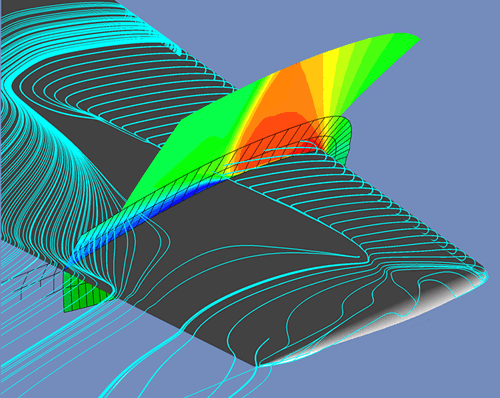
Numerical Simulation: Demonstration by Validation
How can a good numerical simulation be made? With relevant models implemented using a good software! The software and its models must indeed be previously validated in the field where they are used, to expect reliable results.
What is validation in science? It consists in showing that a hypothesis is consistent with the experiment that it is supposed to explain. In numerical simulation, validation consists in showing that a software application, and thus the models that it uses, give results consistent with experiments. The software can then be used with confidence under conditions that are close to those of the validation.

Example of model (red)-experiment (dots) comparison.
Distribution of the pressure coefficient along the outline of a cross-section of the M6 wing, according to the upper and lower surface abscissa.
In flow simulation, it is therefore a case of testing the software's ability to correctly describe the physics of the flow. The development engineer is required to accurately compare the software results with experimental results, in a generic configuration corresponding to its field of use. In practice, there are a large number of configurations, called test cases, which present experimental results in the form of a database, as well as a detailed description of the experimental conditions (geometry, physics, etc.).
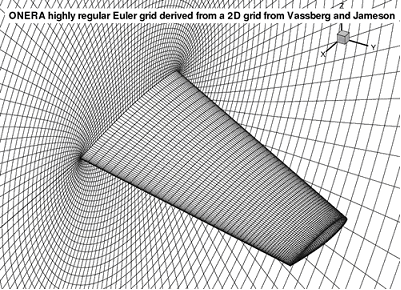
M6 wing grid for CFD calculations, prepared by John C. Vassberg
(Boeing Technical Fellow) and Antony Jameson (professor at Stanford University)
Of course, when software is used in an unusual configuration, it may be necessary to first create a new test case, with the experimental campaign that fits. Validation costs time and money - especially if a series of tests must be performed - but it is a necessary condition for a reliable result. The validation argument must be considered before embarking on choosing software for a given configuration.
The ONERA-M6 Wing
The M6 arrow shaped wing was designed by Bernard Monnerie and his aerodynamicist colleagues at Onera in 1972, within the framework of cooperation within the AGARD2, to serve as experimental support in studies of three-dimensional flows at transonic speeds and high Reynolds numbers5 (conditions representative of the actual flight of military and civilian aircraft). This wing is original due to having been defined in a purely analytical way (that is to say, defined by mathematical equations and not by CAD (Computer Aided Design) or empirically).
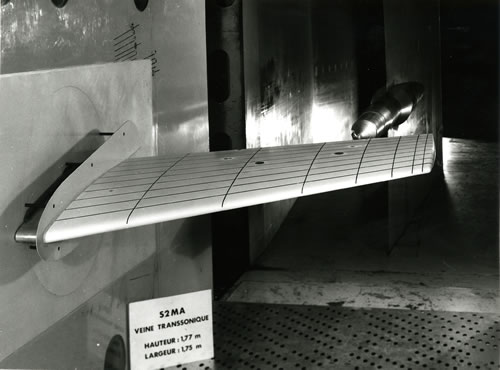
M6 wing in the ONERA S2MA wind tunnel
The series of experiments was conducted in the S2MA wind tunnel (ONERA Modane), with Mach numbers3 of 0.7, 0.84, 0.88 and 0.92 for incidence angles4 of 0 to 6 and a Reynolds number5 of around 12 million.
The results of these tests were recorded in 1979 in an AGARD report by Volker Schmitt and François Charpin, scientists at ONERA. The ONERA-M6 wing5 result database has been used hundreds of times to validate CFD software1 and is still used around the world. This is one of the most "popular" test cases, particularly suited for understanding and evaluating laminar-turbulent transition models, shock wave-boundary layer interaction models, takeoff models, etc., which are characteristic phenomena of what occurs on the wings when approaching the speed of sound.
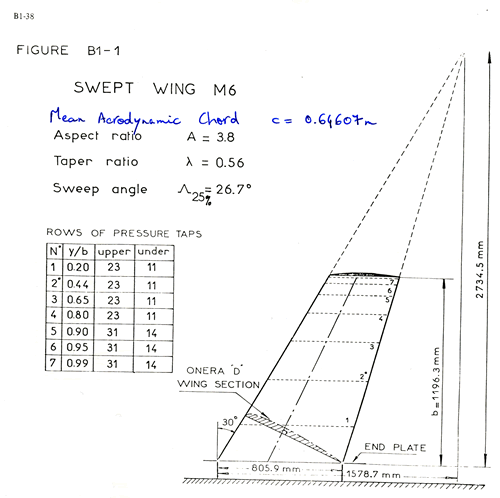

Drawing of the ONERA-M6 wing and the ONERA D profile details that served as a starting point for the design. This symmetrical profile is an experimental fluid mechanics classic.
Some facts about instrumentation:
- 271 pressure ports with 0.8mm diameters on the upper and lower surfaces
- a wall dynamometer with 5 components
- viscous coatings to view parietal current lines
- acenaphthene sublimation to locate the laminar-turbulent transition in the boundary layer
- strain gauge, non-stationary pressure sensor, accelerometers for earthquake analysis
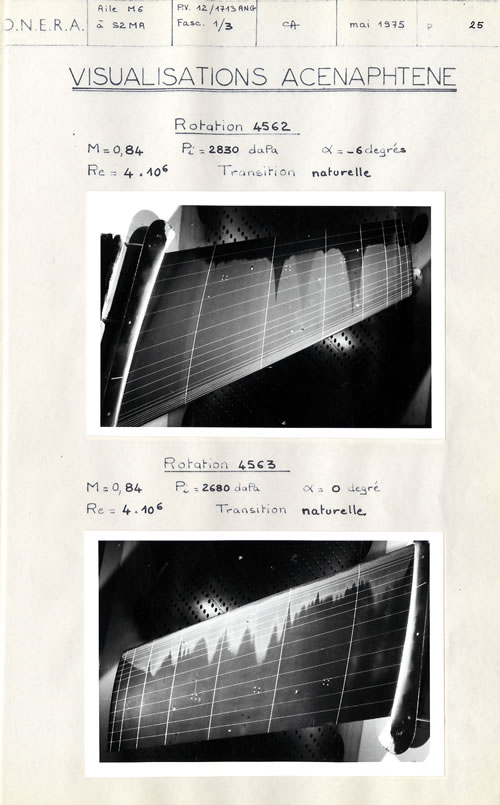
Acenaphthene is a hydrocarbon component of tar. An acenaphthene film spread over the wing has the property of being "ripped off" (we say that it is sublimated) when the flow is turbulent, which helps to differentiate the laminar areas (white) from the turbulent areas (black), with the boundary characterizing the transition.
Notes :
[1] CFD = Computational Fluid Dynamics
[2] AGARD: Advisory Group for Aerospace Research and Development. It was a NATO (North Atlantic Treaty Organization) agency, which existed from 1952 to 1996, whose goals were primarily military. Its role was to facilitate the exchange of information between aerospace research centers. In 1996, the AGARD group merged with NATO’s DRG (Defense Research Group) to form the RTO (Research and Technology Organization). Many databases for validating simulation software, in particular in aerodynamics, have been created and shared among NATO members, under the aegis of the AGARD. The ONERA M6 wing is one of the most famous cases. Onera, a member of the AGARD from the beginning, since became a partner of the RTO.
[3] ] The Mach number (Ma), which is dimensionless, is the ratio between the flow speed and the speed of sound. The Mach number in the air depends on the temperature and thus on the altitude. Mach 0.7 is 0.7 times the speed of sound, or 0.7 x 300 m/s = 210 m/s at an altitude of 10,000 m. Mach 0.7 is 0.7 * 340 m/s = 238 m/s at sea level.
[4] Incidence: angle between the profile chord and the direction of the wind attacking the profile (often denoted alpha)
[5] The Reynolds number (Re) is a dimensionless number used in aerodynamics. It represents the ratio between the inertial forces and viscous forces in the flow. It is an essential parameter for characterizing the flow rate in the boundary layer close to the wall: fully laminar at very low Re, fully turbulent for very large Re, etc.).
[6] The main results concerning the M6 wing are recorded in: Schmitt, V. and Charpin, F., Pressure Distributions on the ONERA-M6 Wing at Transonic Mach Number, AGARD AR 138, May 1979.
Prepared by Sylvain Gaultier, Onera.




